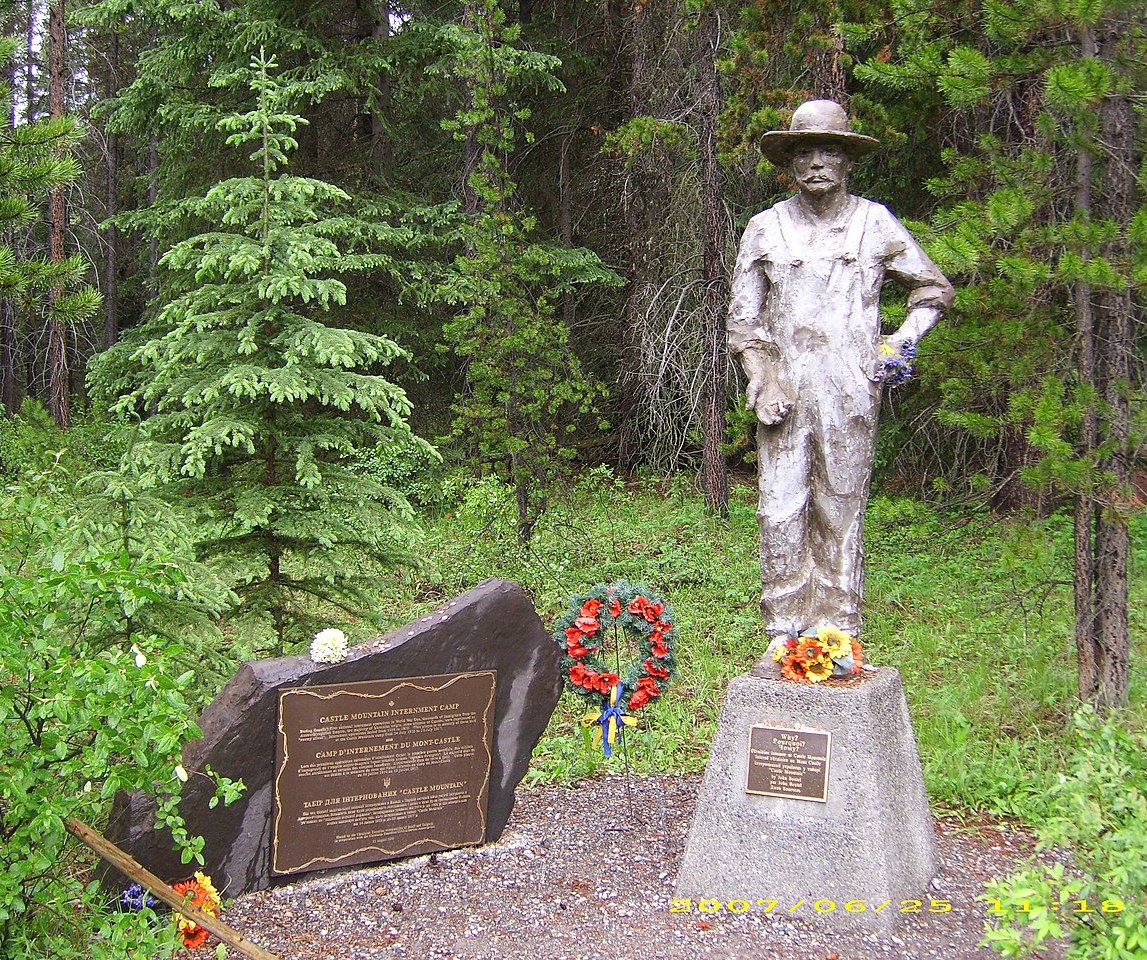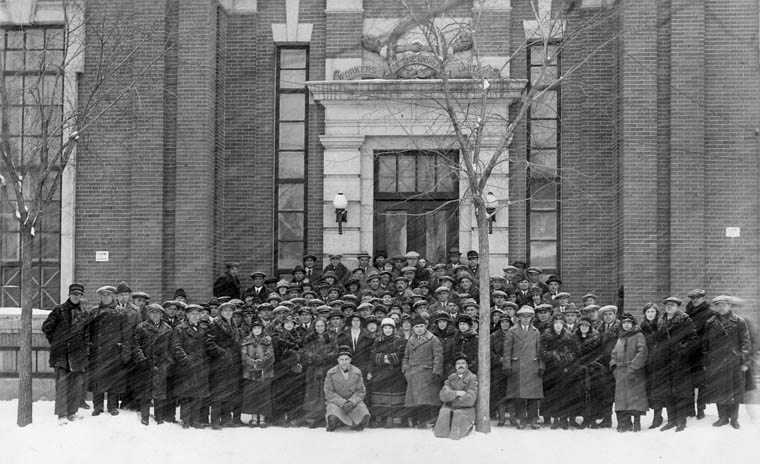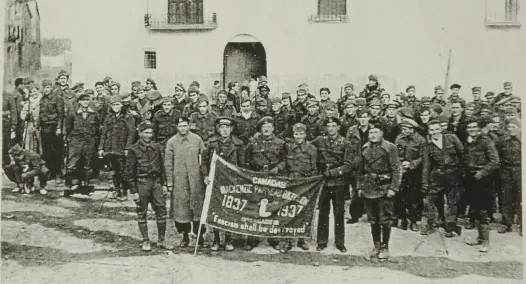Developments of Concern Related to U.S./NATO War Hysteria
Ukrainian Diaspora in Canada

1942 Sudbury photo reflecting the unity of Canadians of Ukrainian, Russian and other communities in the struggle against Nazi-fascism. Placard reads “Long Live the Defenders of Stalingrad,” the sentiment shared by all anti-fascist Canadians.
The government of Canada and cartel parties with seats in the House of Common often make references to the 1.4 million strong Ukrainian population of Canada, said to be the largest in the world outside of Ukraine and Russia. MPs often refer to their Ukrainian constituents suggesting they speak in their name as does the government itself. Despite this, while they are treated as a vote bank, it is rare to see information about who precisely comprises the population of Ukrainian origin in Canada, when and why they came to Canada in the first place, the contributions they have made to Canadian life and their treatment by federal authorities through the years.
The first Ukrainian immigrants came to Canada at the end of the 19th century from western Ukraine, in those days known as Galicia and Bukovyna which were part of the Austro-Hungarian empire. Described as “stalwart peasants,” they were recruited by the government to “populate the Prairies.” They did not come under the preferred category of immigrants which was comprised of Anglo-Saxons and northern Europeans. They came under the second category comprised of Slavs and southern Mediterranean peoples. Then came the categories of “undesirables” which lumped Chinese, Indian and Japanese together as “orientals,” subject to head taxes and exclusion laws of various kinds. Blacks from Africa and the Caribbean were prohibited altogether until the mid-sixties, today categorized as “people of colour” to confound country of origin, nationality, citizenship and race and perpetrate racist stereotypes.
Impoverished, indebted to the landowning class, burdened by heavy taxation and facing conscription in the Austro-Hungarian Army, from 1891 to 1914, more than 10 per cent of the population of western Ukraine emigrated to the United States, Canada and Latin America. By the beginning of World War I, 170,000 Ukrainians had arrived in Canada, spreading first across the prairie provinces, and soon to the mining towns of northern Ontario as well as to Toronto, Montreal and other cities.
Many who homesteaded also worked in the mines, in lumbering or in construction and maintenance of the railways. Reports indicate that their conditions were miserable; they faced super-exploitation, virulent racism, humiliation and brutalization from their employers and those who arranged their emigration and work contracts.
Historians report that many of this “first wave of Ukrainian immigrants” had participated in political and economic struggles against the landed aristocracy at home. They were known for organizing reading clubs to achieve literacy, conducting agrarian strikes, establishing agrarian cooperatives and carrying out political activities to defend their interests. In Canada, they became a fighting contingent of the working class second to none, organizing and joining unions, with many union leaders coming from their ranks.
In 1901, newly arrived immigrants from the Ukraine refused to break a strike by the Brotherhood of Railway Trackmen in Winnipeg and Calgary, despite orders from the immigration officials. They were front and centre in the 1905 strike of the CPR yardmen in Winnipeg, of sewer diggers and general labourers in Edmonton, and freight and coal handlers in the Lakehead who struck in 1906, 1909 and 1912. Osyp Stefaniuk was the first Ukrainian worker to be killed by police on a picket line when they fired into a crowd of workers supporting the Street Railwaymen’s strike in the Lakehead (then Fort William) in 1913. Two Ukrainian workers were shot down in cold blood by the RCMP during the Winnipeg General Strike in 1919.
In the Crowsnest Pass, the miners, many of whom were Ukrainian, fought with courage and dignity to organize themselves and to defend the rights and the dignity of labour. Between 1901 and 1926, there were 181 strikes in Alberta and British Columbia alone, which involved 117,907 men and almost 7 million lost work days.
Workers of Ukrainian origin also established their own social, cultural and political organizations. A Ukrainian branch of the Socialist Party of Canada was organized in 1907, open to all workers, regardless of national origin. It published a weekly newspaper, Red Flag. In 1909 the leader of the Socialist Party was elected to the Alberta legislature representing the constituency of Rocky Mountain, which ran the length of the Rocky Mountains along the Alberta/British Columbia border. The constituency at the time was mainly coal miners, many of whom were from Ukraine. They also joined the Communist Party in large numbers.

Monument to Ukrainians interned at the Castle Mountain internment camp in Alberta during World War I. |
Immigration from Eastern Europe was curtailed with the onset of World War I in 1914 and did not resume until 1923. Immigrants from Ukraine suffered persecution and internment in World War I. Under emergency war powers, 80,000 people who came from territories within the Austro-Hungarian empire were declared to be “enemy aliens.” Most were Ukrainian, and included both Canadian-born and naturalized citizens. They were forced to report regularly to the police, and their organizations and newspapers were banned. Of the more than 8,579 people interned, more than 5,000 were Ukrainians. They were used as forced labour to build the infrastructure of Banff National Park.
As the labour shortage became more acute during the war with so many sent to serve as cannon fodder for the glory of empire, some of those interned were “paroled” though they had never been convicted of any crime, and sent to work on railway maintenance, in the lumber camps, mines and mills. The Canadian Pacific Railway (CPR) received large numbers of workers from the camps. When these workers took strike action to protest the brutal and unsafe working conditions, they were sentenced to six months hard labour for “breach of contract.” The victory of the Great October Revolution led to increased repression by the Canadian state which used the War Measures Act to further criminalize the right to speech and association, ban the publication of newspapers and progressive and labour organizations.
When immigration resumed in 1923, immigrants from Volhynia, which became part of recreated Poland under the Versailles Treaty, joined the “second wave” of Ukrainian immigrants from Galicia and Bukovyna, with about 70,000 Ukrainians coming to Canada between the two world wars.
The Great Depression saw an escalation of state-organized attacks against communists, labour leaders and pro-communist national minority organizations. State-organized divide and rule tactics blamed immigrants for unemployment. Between 1930 and 1935, the Bennett government, using Section 41 of the Immigration Act, deported 26,000 people from Canada for union or political activities or for simply being poor and unemployed, including many Ukrainians. Early in the 1930s, specific measures were taken to discourage immigration of what were considered undesirable classes of Europeans, in particular Finns, Ukrainians, and Jews, singled out for their active participation in independent working class politics. The City of Toronto banned the use of languages other than English in public meetings.

Sixth convention of the Ukrainian Labour temple in Winnipeg in January 1925.
Section 98 of the Criminal Code was enacted in 1919, making it an offence to be a member of an “unlawful association” [1], or “to sell, speak, write or publish anything as the representative or professed representative of any such unlawful association.” The maximum penalty for a violation was 20 years’ imprisonment. Eight leaders of the Communist Party were sentenced to five years in prison under Section 98 in 1931. It was repealed in 1936 after close to half a million Canadians signed a petition demanding its repeal.
Immigrant workers including the Ukrainians who comprised the largest immigrant community, continued to wage militant strike struggles and build their social and cultural organizations and participate in political action. The town council of Blairmore, Alberta, a coal mining town in the Crowsnest Pass, in 1933 declared a civic holiday on the anniversary of the Great October Revolution.
To their great honour, Ukrainians comprised about one third of the more than 1,500 anti-fascist volunteers from Canada who fought with the people’s forces in Spain in the Mackenzie-Papineau Battalion of the XVth International Brigade of the Spanish Republican Army. An estimated 40,000 Canadians of Ukrainian origin joined the Canadian armed forces in World War II.

Members of the Mackenzie-Papineau Battalion fought with the people’s forces in Spain.
World War II also brought renewed repression and resistance. Once more war became the pretext to launch anti-communist and anti-worker attacks across the country. Prior to the outbreak of war, the RCMP had compiled a list of 641 names of possible internees. The list was comprised of communists, leaders of the progressive national minority organizations and trade unionists. It is a matter of public record that the RCMP had no list of fascists in Canada and sympathizers of the Third Reich which would, of course, have had to begin with the Prime Minister of Canada himself, William Lyon Mackenzie King.
With the onset of World War II, progressive workers of Ukrainian origin were once against subject to persecution, arrest and internment. In June 1940 the Communist Party was banned along with 14 other organizations, including the Ukrainian Labour Farmer Temple Association (ULFTA), and 113 anti-fascists were interned, of whom one third were of Ukrainian origin. Arrests continued until May, 1942.
Let us recall that while Ukrainians sympathetic to the anti-fascist cause were being interned and expropriated in Canada, more than 4.5 million Ukrainians joined the Red Army to fight Nazi Germany, and more than 250,000 served in Soviet partisan paramilitary units, dwarfing the numbers of those who volunteered either by choice or by force to join the ranks of the Nazis.
In Canada, the government seized 201 ULFTA properties, including their printing presses and 108 labour temples. Even though banned, the ULFTA continued to organize to demand repeal of the ban, for the release of the internees and return of their halls and printing presses. But the government sold them at firesale prices, often to the reactionary ultra-nationalist groups. Their libraries were burned or the books sold for recycling. Their owners never received proper compensation or even the apologies which have become the stock in trade of the government of Canada.
The “third wave” of Ukrainian immigration took place from 1946 to 1961. This wave was primarily comprised of “displaced persons” brought from the camps created in Europe in the British and American zones to provide refuge for those rescued from slave labour camps, and other refugees from the war. There were approximately six million “displaced persons” in the American and British zones of occupation at the end of the war, the majority victims of the Nazis who took millions of Poles, Ukrainians, Jews and others from occupied territories to Germany to work as slave labour on farms and for monopolies including Thyssen, Krupp, IG Farben, Volkswagen, Fordwerke, Deutsche Bank, Siemens and many others. Many were as young as 12-14 years of age when they were taken from their homelands and many were worked to death, died of starvation, or were executed.
These “displaced persons camps” were also infiltrated by Nazi collaborators, including war criminals. They included leading members of the Organization of Ukrainian Nationalists (OUN) and the Ukrainian Insurgent Army (UPA) as well as the members of the Nazi Waffen SS Division Galizien, all of whose surviving members were cleared to immigrate to Britain and Canada as “displaced persons,” or “political refugees” who were “fleeing communism.”
The “fourth wave” of immigration from Ukraine followed the collapse of the former Soviet Union. An estimated 60,000 Ukrainians have immigrated to Canada since 1991. Amidst neo-liberal globalization and rampant corruption, Ukraine has become the poorest country in Europe, a reserve of migrant labour. From a population of around 52 million when the Soviet Union was dissolved, today, prior to the exodus of refugees in the current war, the population of Ukraine was estimated at between 41 and 44 million.
In summary, the first immigrants from Ukraine came from territories within the Austro-Hungarian Empire, from a life of poverty and exploitation by the landed aristocracy. After WW2 the vast majority were victims of fascism. Today it is the neo-liberal, anti-social offensive, corruption and take-over of Ukraine by narrow private interests, especially the likes of George Soros that turned Ukraine once again into a reserve of migrant labour on the world market.
The Ukrainian community in Canada has a proud history as a fighting contingent of the Canadian working class and people, including in the fight to defeat fascism. They are not represented by the reactionary nationalists and Nazi collaborators called freedom fighters who came to Canada after World War II with the support of the state and cartel parties. Remnants of the feudal aristocracy who lost power following the Great October Revolution, they are virulent anti-communists. They allied themselves with Nazi Germany in its failed attempt to defeat the Soviet Union and fought for an independent Ukraine that would restore their lands and titles. Their freedom and democracy is not that of the people of Ukraine but for the restoration of their lost properties and titles. This is the origin of their hatred for anything Russian and the revanchism which oozes out of their every pore as they vow to kill President Putin, crush Russia and obliterate it from the map of the world.
The Canadian state and its governments and officials meet any opposition to these arch-reactionaries who have infiltrated and even taken over certain universities as well as government ministries with a storm of accusations of being “anti-Ukrainian” and spreading hate propaganda while governments have provided millions of dollars to build monuments in praise of Nazi collaborators and so-called victims of communism. Chauvinism, virulent hatred against Russia, the glorification of Nazi collaborators then and neo-Nazis today is a blight on Canada’s claim to be democratic and peace-loving. It does not now and never represented the working class and people of Ukrainian origin in Canada. The stranglehold of arch-reaction is such that now the salute of the Nazi collaborators during World War II, “Glory to Ukraine, Glory to the Heroes!” – similar to the Nazi salute “Heil Hitler!” – has been introduced by the Deputy Prime Minister, the Prime Minister and others as official Canadian policy. Declaring that such slogans do not have the same meaning today as they did during the war is an excuse beneath contempt.
Notes
1. Section 98 banned organizations, including political parties, whose “professed purpose” was to bring about “any governmental, industrial or economic change within Canada by use of force, violence or physical injury to person or property, or by threats of such injury, or which teaches, advocates, advises or defends the use of force, violence, terrorism, or physical injury to person or property: to bring about political or economic change” or any other “such purpose” or “teach, advocate, advise or defend” such purpose.
(TML Daily, posted March 16, 2022. Hardial Bains Resource Centre Library and Archives. Photo: radtek67)



